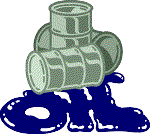1999 Student Recipients
As participants in the second annual Internet Science and Technology Fair
(ISTF), 38 student teams from around the country surfed the Net in
search of answers to critical technology concerns facing
America.
This year's two winning teams are the Fairgrounds Junior
High School team from Nashua, New Hampshire with their project entitled S.O.S. (Stopping
Oil Spills), and the Mainland High School team from Daytona Beach,
Florida with a project entitled Turtle Lights. In recognition of
their accomplishments, each team will receive a Certificate of Meritorious
Achievement from the Department of Commerce's National Medal of Technology
program. Five other teams received honorable mention from the College of
Engineering at the University of Central Florida, which developed and
administers the Fair. A distinctive feature of ISTF is that students do all of the
research for their projects via email and the Internet--from tracking down
articles and consulting technical advisors in corporations and academia to
submitting the results of their research in the form of web sites.
A distinctive feature of ISTF is that students do all of the
research for their projects via email and the Internet--from tracking down
articles and consulting technical advisors in corporations and academia to
submitting the results of their research in the form of web sites.
Yet ISTF is about more than students learning their way around the
Internet. "First and foremost, we want to pique students' interest in
science and engineering and increase their 'technology literacy,'"
explains Bruce Furino of the University of Central Florida, ISTF's
director. "The more comfortable they are working with technology related
issues, the more likely it is that they will consider careers in
technology related fields," Furino says.  Working
in teams, students first choose a technical topic involving one of the
National Critical Technologies identified by the White House Office of
Science and Technology Policy. Categories range from energy and
transportation to living systems and environmental quality. The students
then use on-line resources to define the problems involved in the topic
selected, and to explore existing or potential technologies relevant to
solving those problems. Results of the students' efforts are presented as
"Project Homepages" on the World Wide Web, and these are evaluated by a
panel of expert judges.
Working
in teams, students first choose a technical topic involving one of the
National Critical Technologies identified by the White House Office of
Science and Technology Policy. Categories range from energy and
transportation to living systems and environmental quality. The students
then use on-line resources to define the problems involved in the topic
selected, and to explore existing or potential technologies relevant to
solving those problems. Results of the students' efforts are presented as
"Project Homepages" on the World Wide Web, and these are evaluated by a
panel of expert judges.
For the first time, this year's program
included a level of participation specifically for senior high students,
in addition to the level for junior high and middle school students. Next
year, a level for elementary school students will be included in the
competition. The content standards which each team must address are based
on National Science Education Standards developed by the American
Association for the Advancement of Science (AAAS).
This year's
results and the expanded levels of participation bode well for ISTF's
future. As Furino notes, "It's gratifying to see the effort that the
students are putting into their projects. Having three levels of
participation next year means even more young people will have the chance
to take part in an experience that is not only fun and exciting but a
marvelous opportunity to prepare for tomorrow's challenges."
(Click on either image to visit the respective Project Homepage of
this year's winners.)
![[rotating Medal/DOC seal]](1999_files/redmedal.gif)
![[National Medal of Technology]](1999_files/banner2b.jpg)
![[small medal]](1999_files/sm_medal.gif)